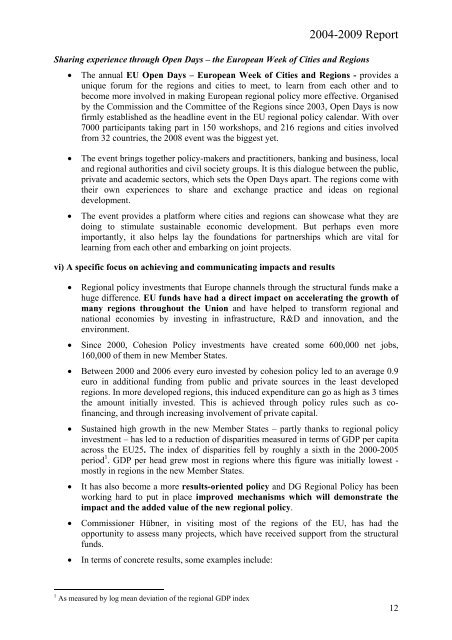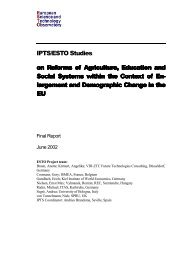Achievements of Europe's regional policy 2004-2009 - Et2050.eu
Achievements of Europe's regional policy 2004-2009 - Et2050.eu
Achievements of Europe's regional policy 2004-2009 - Et2050.eu
You also want an ePaper? Increase the reach of your titles
YUMPU automatically turns print PDFs into web optimized ePapers that Google loves.
<strong>2004</strong>-<strong>2009</strong> Report<br />
Sharing experience through Open Days – the European Week <strong>of</strong> Cities and Regions<br />
• The annual EU Open Days – European Week <strong>of</strong> Cities and Regions - provides a<br />
unique forum for the regions and cities to meet, to learn from each other and to<br />
become more involved in making European <strong>regional</strong> <strong>policy</strong> more effective. Organised<br />
by the Commission and the Committee <strong>of</strong> the Regions since 2003, Open Days is now<br />
firmly established as the headline event in the EU <strong>regional</strong> <strong>policy</strong> calendar. With over<br />
7000 participants taking part in 150 workshops, and 216 regions and cities involved<br />
from 32 countries, the 2008 event was the biggest yet.<br />
• The event brings together <strong>policy</strong>-makers and practitioners, banking and business, local<br />
and <strong>regional</strong> authorities and civil society groups. It is this dialogue between the public,<br />
private and academic sectors, which sets the Open Days apart. The regions come with<br />
their own experiences to share and exchange practice and ideas on <strong>regional</strong><br />
development.<br />
• The event provides a platform where cities and regions can showcase what they are<br />
doing to stimulate sustainable economic development. But perhaps even more<br />
importantly, it also helps lay the foundations for partnerships which are vital for<br />
learning from each other and embarking on joint projects.<br />
vi) A specific focus on achieving and communicating impacts and results<br />
• Regional <strong>policy</strong> investments that Europe channels through the structural funds make a<br />
huge difference. EU funds have had a direct impact on accelerating the growth <strong>of</strong><br />
many regions throughout the Union and have helped to transform <strong>regional</strong> and<br />
national economies by investing in infrastructure, R&D and innovation, and the<br />
environment.<br />
• Since 2000, Cohesion Policy investments have created some 600,000 net jobs,<br />
160,000 <strong>of</strong> them in new Member States.<br />
• Between 2000 and 2006 every euro invested by cohesion <strong>policy</strong> led to an average 0.9<br />
euro in additional funding from public and private sources in the least developed<br />
regions. In more developed regions, this induced expenditure can go as high as 3 times<br />
the amount initially invested. This is achieved through <strong>policy</strong> rules such as c<strong>of</strong>inancing,<br />
and through increasing involvement <strong>of</strong> private capital.<br />
• Sustained high growth in the new Member States – partly thanks to <strong>regional</strong> <strong>policy</strong><br />
investment – has led to a reduction <strong>of</strong> disparities measured in terms <strong>of</strong> GDP per capita<br />
across the EU25. The index <strong>of</strong> disparities fell by roughly a sixth in the 2000-2005<br />
period 1 . GDP per head grew most in regions where this figure was initially lowest -<br />
mostly in regions in the new Member States.<br />
• It has also become a more results-oriented <strong>policy</strong> and DG Regional Policy has been<br />
working hard to put in place improved mechanisms which will demonstrate the<br />
impact and the added value <strong>of</strong> the new <strong>regional</strong> <strong>policy</strong>.<br />
• Commissioner Hübner, in visiting most <strong>of</strong> the regions <strong>of</strong> the EU, has had the<br />
opportunity to assess many projects, which have received support from the structural<br />
funds.<br />
• In terms <strong>of</strong> concrete results, some examples include:<br />
1 As measured by log mean deviation <strong>of</strong> the <strong>regional</strong> GDP index<br />
12







